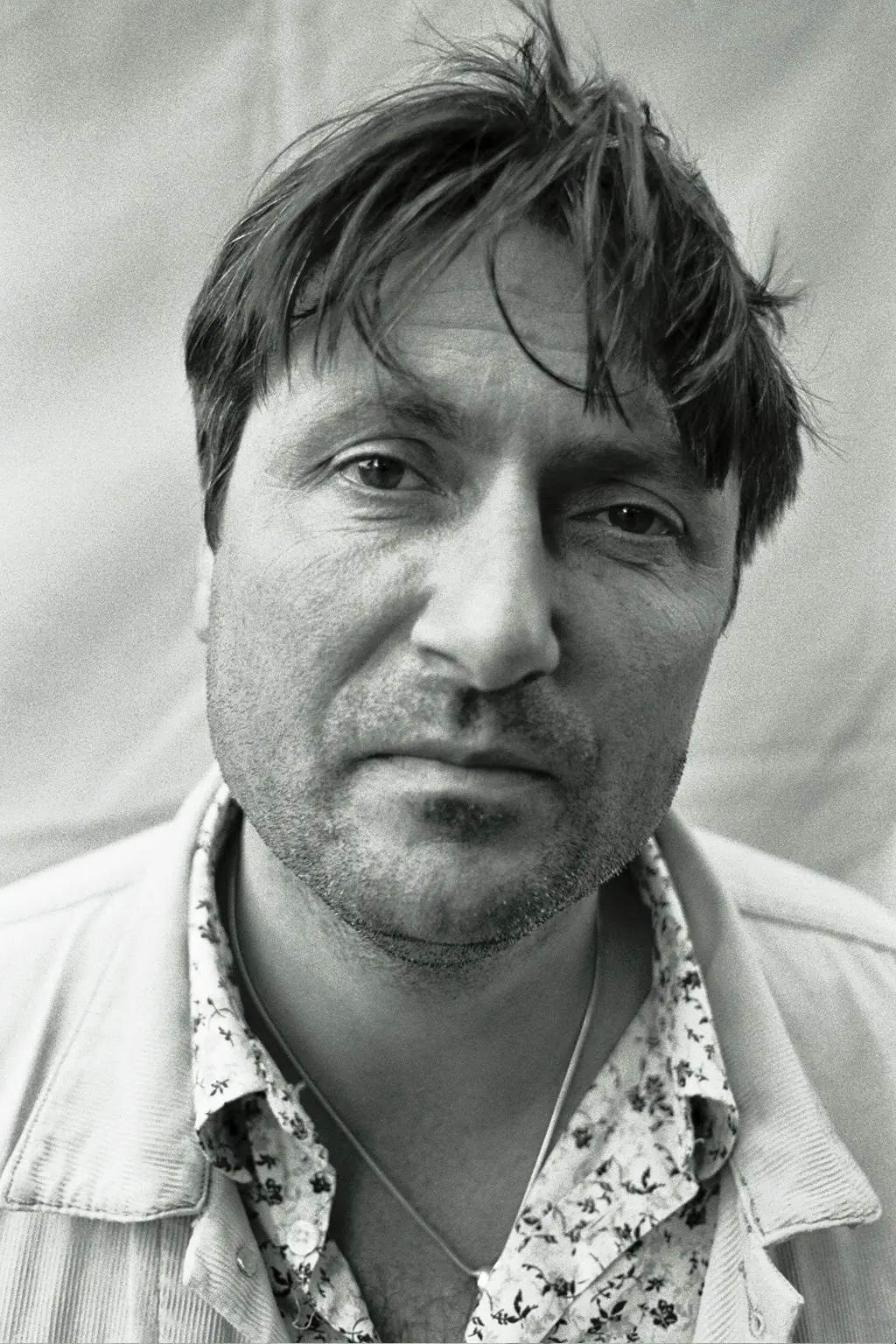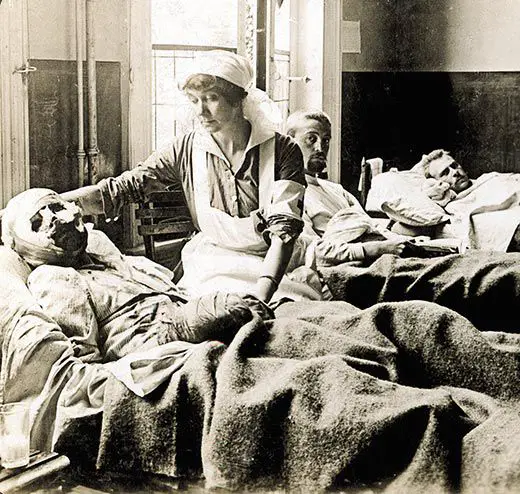
FULL POEM - SCROLL DOWN FOR LINE-BY-LINE ANALYSIS
After the first phase,
after passionate nights and intimate days,
only then would he let me trace
the frozen river which ran through his face,
only then would he let me explore
the blown hinge of his lower jaw,
and handle and hold
the damaged, porcelain collar-bone,
and mind and attend
the fractured rudder of shoulder-blade,
and finger and thumb
the parachute silk of his punctured lung.
Only then could I bind the struts
and climb the rungs of his broken ribs,
and feel the hurt
of his grazed heart.
Skirting along,
only then could I picture the scan,
the foetus of metal beneath his chest
where the bullet had finally come to rest.
Then I widened the search,
traced the scarring back to its source
to a sweating, unexploded mine
buried deep in his mind, around which
every nerve in his body had tightened and closed.
Then, and only then, did I come close.

LINE-BY-LINE ANALYSIS
COUPLET 1
After the first phase,
after passionate nights and intimate days,
The first couplet describes the intimacy in their relationship after the ‘first phase’ which we assume to be the first period of his time at war. The adjectives ‘passionate’ and ‘intimacy ‘create a loving, positive tone to describe this joyful time.
COUPLET 2
only then would he let me trace
‘Only then’ suggests that it took her a lot of persuasion and attention for him to become comfortable opening up to her, signifying the extent of physical and psychological damage he has experienced.
the frozen river which ran through his face,
This poignant piece of imagery symbolises the physical and psychological torment inflicted upon the man. Physically, the ‘frozen river’ portrays a scar – the imagery of ‘frozen’ suggests a harsh roughness to it. Psychologically, it represents the drying up of the man’s emotions that used to flow like a ‘river’ but are now fixed and unmoved.
COUPLET 3
only then would he let me explore
The anaphora of ‘only then’ emphasises the idea that it is a struggle to comfort the man.
the blown hinge of his lower jaw,
Taken literally, this line is a brutal description of the man’s injured ‘lower jaw’ from fighting. Quite simply, its harrowing nature paints a vivid picture of the evils of war. Metaphorically, it represents that war has rendered him speechless and forced a kind of introverted nature upon him. The caesura at the end of the couplet conveys a finality to his physical and emotional injuries.
COUPLET 4
and handle and hold
The polysyndeton of ‘and’ further highlights the constant struggle and extensive process of caring for the man. ‘Handle and hold’ suggest a child-like fragility to the man,
the damaged, porcelain collar-bone,
The key thing to take from this couplet is the description of his ‘collar-bone’ as ‘porcelain’. ‘Porcelain’ is a ceramic material and its effect in this context is to illustrate the delicate, brittle, but also precious nature of his collar-bone.
COUPLET 5
and mind and attend
‘mind’ and ‘attend’ are caring verbs and show her attentiveness towards the man. ‘Attend’ suggests an obligation to this care like one would ‘attend’ a meeting hinting that the woman finds caring for him tedious.
the fractured rudder of shoulder-blade,
The image of ‘rudder’ is a naval symbol and is used to steer boats. The fact the ‘rudder’ is ‘fractured’ signifies the man’s lack of direction and inability to carve his own path in war and general life.
COUPLET 6
and finger and thumb
‘Finger and thumb’ reinforces the sense of intimacy between them due to the sensory image of close contact it paints. This intimacy is why we can assume that they are a married couple.
the parachute silk of his punctured lung.
The ‘silk’ repeats the delicate imagery of previous couplets. Silk also paints a picture of the, almost luxurious, softness of his ‘lung’ which juxtaposes the fact that it is ‘punctured’.
COUPLET 7
Only then could I bind the struts
‘Bind the struts’ describes the woman fastening together some form of rod which will come together to form a splint for the man.
and climb the rungs of his broken ribs,
‘Rungs’ are the horizontal supports on a ladder and the imagery of climbing this ladder signifies, for the man, that he is at the bottom of this ladder in a place of physical and emotional torment and the ascension of the ladder, although strenuous and difficult, will take him to a place of recovery, giving a sense of hope. The strenuous ascent of the ladder also relates to the woman’s arduous journey to heal her husband.
COUPLET 8
and feel the hurt
of his grazed heart.
‘Hurt’ and ‘heart’ are a classic example of half-rhyme. In this case, it represents the disconnect between the man’s physical ‘hurt’ with the emotions he feels as represented by his ‘heart’. Armitage describes the man’s heart as ‘grazed’ which, although an image of pain, is more delicate than other adjectives, continuing the fragile description of him.
COUPLET 9
Skirting along,
only then could I picture the scan,
The woman begins to see the bigger picture or ‘scan’ (which has strong medical connotations) suggesting a progression for her caring of him.
COUPLET 10
the foetus of metal beneath his chest
This line is full of points to analyze. The ‘foetus’ image links to the bullet implanting in the body of the man like a baby would in a woman. From this, Armitage also gives us some interesting parallels between the perception of men and woman. The ‘foetus’ represents the life-changing nature of the man’s nature just like the life-altering birth of a child.
where the bullet had finally come to rest.
The bullet ‘coming to rest’ has strong parallels with death – when a person dies it is often said that they come to rest. Armitage plays with the fact that this ‘dead’ bullet is pushing the man to close to death, creating a sense of irony.
COUPLET 11
Then I widened the search,
‘Widening the search’ relates back to the title of the poem. A title that we have almost forgotten amidst the seemingly unrelated injuries and treatment of the man. This line helps us make a connection to the title. Her manhunt is both physical for his injuries but also psychological as she attempts to rediscover her former husband and connection.
traced the scarring back to its source
By tracing the ‘scarring back to its source’ it indicates that there is more extensive pain that has previously been hidden from her. In the next couplet, we learn that this ‘source’ is psychological trauma.
COUPLET 12
to a sweating, unexploded mine
buried deep in his mind, around which
The ‘unexploded mine’ is an example of war imagery which provides further insight into how the man received his injuries. It is ‘unexploded’ creating a suspenseful feeling of an inevitable explosion, where man’s psychological trauma suddenly erupts at once in an emotionally destructive outbreak.
COUPLET 13
every nerve in his body had tightened and closed.
This is an unnatural image that has connotations of death, as his nerves ‘tightening’ and ‘closing’ imply a shutting down of his body.
Then, and only then, did I come close.
This last line emphasises the fact that the woman didn’t fully reconnect with her husband, but she did ‘come close’. She traced the ‘unexploded mine’ but as it was ‘buried deep in his mind’ she didn’t stand a chance f resolving it and fully reconnecting with him.


